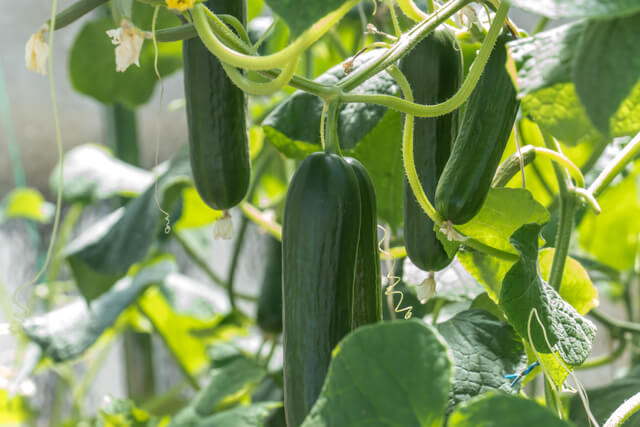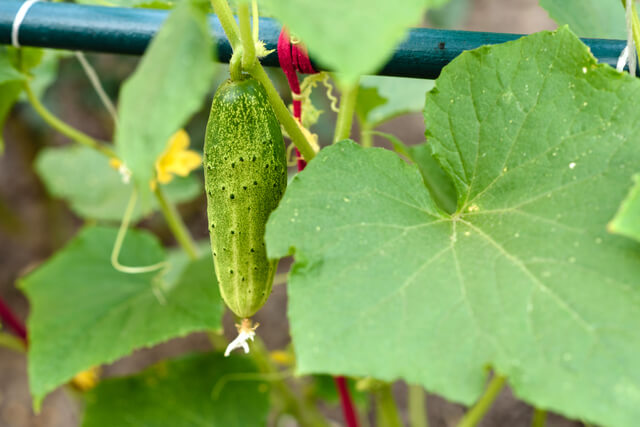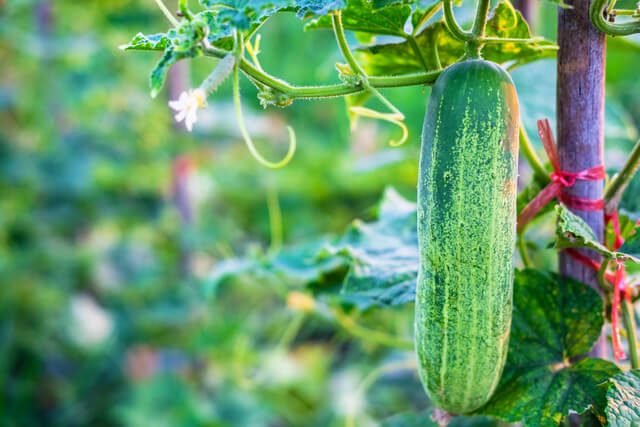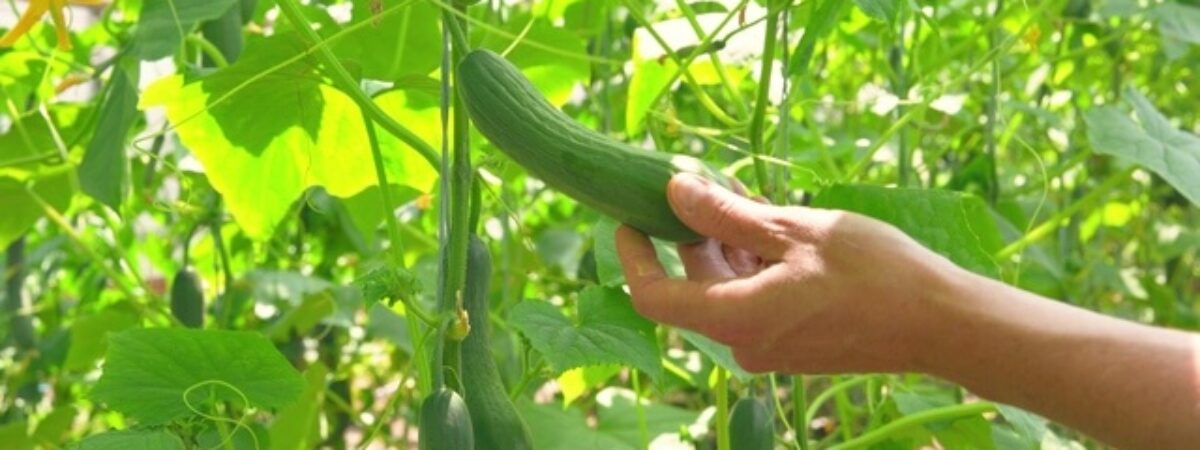Cucumbers are scientifically called Cucumis sativus and belong to the family of Cucurbitaceae. These are also commonly called gherkins.
Cucumbers are annual plants and are quite easy to grow. There are around hundreds of varieties in cucumber such as round cukes, yellow cukes, skinny English cukes, and exotic Armenian cukes.
But out of these many varieties, long and green cucumber varieties are mostly grown and more popular, especially in gardens. The cucumbers that are grown at home tend to be more crunchy and delicious. Click To TweetBut out of these many varieties, long and green cucumber varieties are mostly grown and more popular, especially in gardens. The cucumbers that are grown at home tend to be more crunchy and delicious.
Cucumbers can be eaten in two ways such as slicing the cucumber and pickling the cucumber slices as well. Rather triangular leaves are found on cucumbers, and all of the leaves are pointed with a rough, prickly texture.
A cucumber flower is typically yellow and monoecious, producing fruits from both male and female blooms, but some hybrids are being bred to be parthenocarpic, meaning that they produce only female blooms that self-pollinate.
Usually cucumber fruits are either one or two inches long, but can grow to be over a foot long. Some cucumber varieties are round as well.
There is usually a layer of green or yellow outside the skin that can either be delicate or tough.
Spines are commonly found in most varieties that can be cleaned easily. Seedless varieties are commonly found in parthenocarpic varieties. They can be grown in USDA Hardiness zones of 4-11.

Varieties
With cucumbers, you can experiment with different sizes, colors, and shapes to find out what looks the best, grows best, and tastes the best.
Marketmore
It is one of the easiest varieties to grow and most prolific one.
Lemon
With a generous amount of seeds, this pale yellow heirloom fruit is edible as a bowl when the seeds are scooped out.
Armenian (Cucumis melo)
The skin is thin and crunchy; they are somewhat exotic in appearance and have ridges and stripes.
English
It grows in hothouses or greenhouses and has thin skin and a mild flavor. It requires a long season to grow.
Bush champion, spacemaster and bushmaster
A great choice for container gardening
Usually cucumbers grow fully mature in around 70 days. These are grown from seeds or by transplanting. Wait until the frost has passed and the soil temperature becomes 70 degrees fahrenheit. Click To TweetGrowing Guide
Usually, cucumbers grow fully mature in around 70 days. These are grown from seeds or by transplanting. Wait until the frost has passed and the soil temperature becomes 70 degrees fahrenheit.
The seeds should be planted in rows and the soil should be well drained and rich in compost. If you want to transplant the plant, then you can grow the seeds indoors before one month of planting season.
The seeds should be planted 1 inch deeper and at a distance of 4 to 6 inches from each other. You will notice the seeds germinating within 7 to 10 days. Make sure to keep the seeds a little warmer for germination.
If the temperature falls down to below 50 degrees celsius then it might harm the germination process as low temperatures slow down the germination process.
Mulching is the best way to provide the seeds with optimum temperatures for their germination and also keep them free from weed infestation along with that it helps in retaining moisture required for the seedlings to grow.
When the seedlings reach upto a height of 4 inches, prune them with the help of pruning shears, so that there will be healthy growth. Usually the female plant blooms later than that of male plants.

Caring Guide
Soil
Cucumbers prefer well drained soil that is rich in compost and organic matter content. They prefer to grow in neutral to acidic soil having a pH of 5.5 to 7. However they can be grown in any type of soil.
Light
These plants are best grown under bright direct Sunlight. They require at least six hours of exposure to Sunlight in a day.
Water
Water is most important for these plants, so regular watering is required to grow them healthier and tastier.
However they cannot tolerate too much wet soil, so there should be proper drainage conditions as well. If they are watered less frequently then the fruit will taste bitter.
Temperature and Humidity
Cucumbers thrive well in humid and dry climatic conditions. They usually grow in hot temperatures during day time and warmer temperatures during night time.
Fertilizer
Cucumbers are basically heavy feeders. It is best to feed them with organic fertilizers as they will slowly release the fertilizers and provide adequate nutrients to the plants along with that they make the soil fertile.
Usually the fertilizer should be applied as side dressing and during the blooming season of the plant. Another dose should be applied during the middle of the season which is about two to three weeks.
Harvesting
On an average, Cucumbers basically grow up to a size of 3 to 8 inches. This is the ideal size to harvest the vegetable. The more they grow, the less will be the taste of the vegetables.
If the cucumber variety you are growing is the seeded one, then they produce more seeds pulp as they mature. Even the plant will stop producing vegetables after that.
The best way to harvest them is to cut the cucumbers from the vine with the help of a scissor as the vines are quite prickly to touch with bare hands. You can even twist the stem of the cucumbers.
Do not try to pull the vegetables from the plant as that will harm the vines of the plant. Sometimes the cucumber might taste bitter at the ends particularly.
However you can keep the freshly harvested cucumbers in the refrigerator by wrapping them in a plastic bag. They can be easily sliced and can be eaten as salads at any time.

Problems in Cucumber
It is possible for cucumbers to succumb to a few bug and disease problems, but where you grow them greatly determines how detrimental these bugs can be to your crop.
Whitefly
Mostly the whitefly infestation occurs in greenhouse cultivation of cucumbers, however it can attack the plants outside also. The best way is to eradicate the infested plants from other healthier ones.
Red spider mite
These usually attack the greenhouse plants, but they can also attack them on the ground. However these insects cannot tolerate humid conditions.
So it is better to keep the soil moist so that these insects won’t attack the plants.
Powdery Mildew
Less watering to the plants leads to powdery mildew infection. When you notice the infection in your plant, it is better to remove the infected leaves from the plant and throw them.
This way it can be prevented from further spreading of the disease. To prevent it from occurring, it is better to regularly water the cucumber plants.
Conclusion
As you have read this article so far, I hope you have acquired some information regarding growing and caring of Cucumbers in your own garden.
Cucumbers that are freshly grown are ready to chop, toss into salads or dip into your favorite dip. They are also a tasty garnish for cocktails.
So you should definitely start growing Cucumbers in your vegetable garden by following our simple and effective guide.






